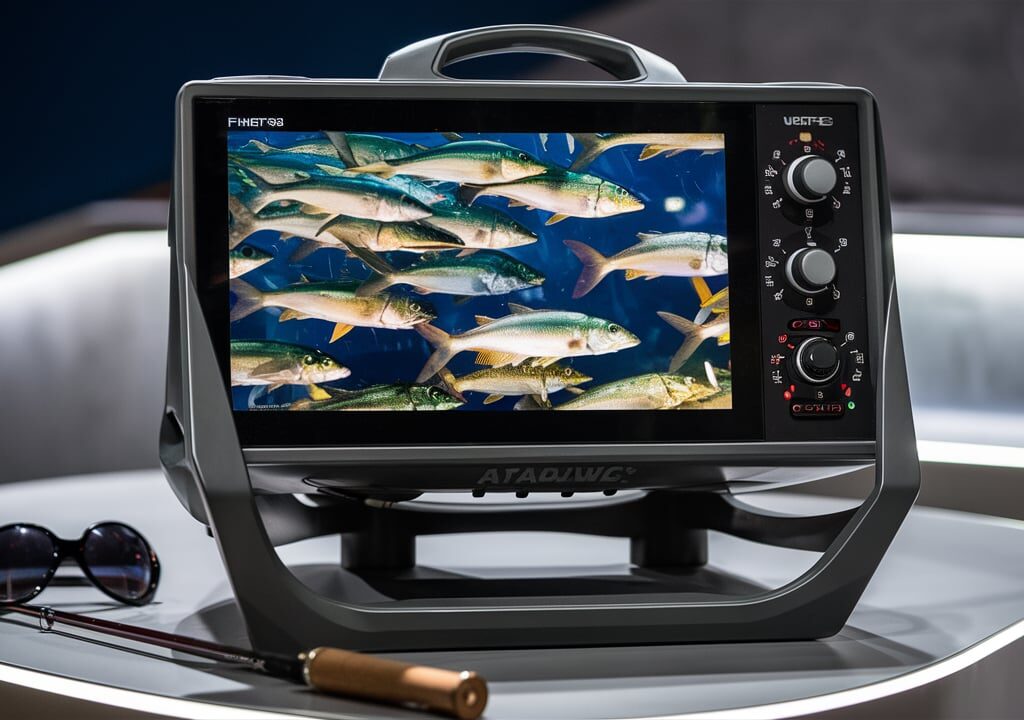Fishing trips can be more rewarding with the right tools. A fish finder is essential for locating fish.
This blog will explore the key features to look for in a fish finder. Fishing can be challenging without the proper equipment, and a fish finder can make all the difference. With the right features, a fish finder can turn a frustrating fishing trip into a successful one.
Understanding these features helps you choose the best fish finder for your needs. From display clarity to GPS capabilities, these elements enhance your fishing experience. Knowing what to look for ensures you make an informed decision, leading to more fruitful fishing adventures. Let’s dive into the essential features that will help you catch more fish and enjoy your fishing trips more.
Display Quality
Choosing the right fish finder can make all the difference in a successful fishing trip. One of the most important features to consider is the display quality. A good display can help you see fish and underwater structures more clearly. This can lead to better decision-making while fishing. Let’s explore the key aspects of display quality: screen resolution and screen size.
Screen Resolution
Screen resolution refers to the number of pixels on the display. Higher resolution means more pixels, resulting in a clearer image. You can see more details, making it easier to spot fish. High resolution also helps in identifying underwater structures. It is crucial for accurate fish finding.
Screen Size
Screen size is another important factor. A larger screen provides more viewing area. This can make it easier to read the data. You can see more information at a glance without straining your eyes. A bigger screen is especially helpful in bright sunlight. It enhances your overall fishing experience.
Sonar Technology
Sonar technology is essential for any fish finder. It helps detect fish and underwater structures. With sonar, you get a clear view of what’s under the water. This technology can make your fishing trips more successful and enjoyable.
There are different types of sonar technology available. Each type has unique features. Here are two key types to consider:
Chirp Sonar
CHIRP sonar stands for Compressed High-Intensity Radar Pulse. It uses a range of frequencies to scan the water. This provides better detail and accuracy. CHIRP sonar helps you see fish and structures more clearly. It reduces noise and improves target separation.
With CHIRP sonar, you can spot fish even in deep waters. It gives you a clearer picture of what’s below. This makes your fishing experience more productive.
Dual Beam
Dual beam sonar uses two beams to scan the water. One beam is narrow, and the other is wide. The narrow beam provides detailed images. The wide beam covers a larger area.
Dual beam sonar is great for different fishing environments. It helps you see both small details and the bigger picture. This type of sonar is versatile and useful for many fishing conditions.
Choosing a fish finder with dual beam sonar can improve your chances of catching fish. It gives you a balanced view of the underwater world.
Gps Integration
GPS integration in fish finders is a crucial feature for successful fishing trips. This technology helps anglers navigate waters with confidence. It ensures a more productive and enjoyable experience on the water.
Fish finders with built-in GPS offer several advantages. They help track your position, create detailed maps, and mark specific spots. Let’s explore these features in detail.
Mapping Capabilities
GPS integrated fish finders provide excellent mapping capabilities. They allow you to create and view detailed maps of fishing areas. These maps help identify underwater structures and potential fishing spots. High-resolution maps offer a clear view of the underwater environment. This information helps in making informed decisions about where to fish.
Some fish finders also feature preloaded maps. These maps cover popular lakes, rivers, and coastal areas. You can update these maps for the latest information. This ensures you always have accurate data for your fishing trip.
Waypoint Marking
Waypoint marking is another valuable feature of GPS integrated fish finders. It allows you to mark specific locations of interest. These could be spots where you found fish or unique underwater structures. Waypoints help you easily return to these spots on future trips. This saves time and increases your chances of a successful catch.
You can mark waypoints with a simple button press. Some fish finders allow you to add notes to each waypoint. This helps in remembering why you marked the spot. Organizing and managing waypoints becomes easier with this feature.
Depth Capability
Depth capability is a vital feature in a fish finder. It determines how deep the device can scan underwater. Understanding this feature can enhance your fishing experience, making it more productive. Two critical aspects within depth capability include maximum depth and shallow water performance.
Maximum Depth
A fish finder’s maximum depth is how deep it can effectively scan. This is important for deep-sea fishing. Look for a device that offers a high maximum depth. This ensures you get accurate readings even in deep waters. Some models can scan depths of up to 1,000 feet or more.
Shallow Water Performance
Not all fishing happens in deep water. Shallow water performance is crucial for coastal and freshwater fishing. A good fish finder should provide clear images in shallow waters. This helps you spot fish easily. Ensure the device can switch between deep and shallow water modes smoothly. This flexibility will improve your fishing experience.
Portability
Portability is a key feature in a fish finder. A portable device makes fishing trips easier. It allows you to move around without being tied to one spot. This is ideal for those who fish from different boats or locations.
Mounting Options
Look for flexible mounting options. Suction cup mounts are easy to attach and remove. They work well on various surfaces. Bracket mounts offer more stability. They are ideal for rough waters.
Battery Life
Long battery life is crucial for a portable fish finder. It ensures your device lasts throughout your fishing trip. Check for devices with rechargeable batteries. These are more cost-effective in the long run. Also, consider a fish finder with a power-saving mode. This feature helps extend the battery life.
User Interface
A fish finder’s user interface plays a vital role in its functionality. It can make or break your fishing experience. A good interface ensures that even beginners can use it with ease.
Ease Of Use
The interface should be simple and intuitive. Complex systems can confuse users. Clear icons and labels help in understanding the functions quickly. A touchscreen can add to the ease of use, making selections more straightforward.
Menu Navigation
Menu navigation should be smooth and logical. Users should find what they need without digging through endless options. A well-organized menu saves time. It helps you focus more on fishing and less on settings.
Durability
Durability is a vital feature in a fish finder. Fishing trips can expose your gear to harsh conditions. A durable fish finder ensures longevity and reliability. It will withstand tough environments and accidental drops. Let’s explore the key aspects of durability in fish finders.
Waterproof Rating
A high waterproof rating is crucial. Your fish finder must resist water exposure. Check for a rating of at least IPX7. This ensures the device can handle immersion in water. A good waterproof rating protects internal components from damage. It keeps the device functional during unexpected downpours or splashes.
Build Quality
Build quality is another important factor. Look for sturdy materials like reinforced plastic or metal. These materials add strength and durability. A well-built fish finder can withstand rough handling. It should also have secure seals to prevent water ingress. Quality construction ensures the device lasts longer and performs better.
Additional Features
Many fish finders offer GPS capabilities, which help in navigating waters efficiently. Some have sonar imaging for clear underwater visuals. Wi-Fi connectivity allows for easy updates and data sharing.
When it comes to making the most out of your fishing trips, having a fish finder with additional features can make all the difference. These features go beyond the basic functionalities, offering you enhanced connectivity and smarter integrations. Let’s dive into a couple of these key additional features that can significantly improve your fishing experience.Wi-fi Connectivity
Wi-Fi connectivity in a fish finder can be a game-changer. Imagine being able to download the latest maps and software updates directly to your device without any hassle. You can even share your fishing spots and data with friends in real-time. For example, last summer, I found an excellent fishing spot and immediately shared the coordinates with my buddy, who was fishing a few miles away. Thanks to Wi-Fi connectivity, we both had a fantastic day catching fish. Wi-Fi also enables you to back up your fishing data to the cloud. This is particularly useful if you switch devices or need to reset your fish finder. You won’t lose any valuable information.Smartphone Compatibility
A fish finder with smartphone compatibility takes convenience to the next level. With this feature, you can control your fish finder directly from your smartphone. This is especially handy when you’re moving around the boat and want to keep an eye on the fish without being glued to the device. You can also receive notifications and alerts on your phone. If the fish finder detects something interesting, you’ll know immediately. Another advantage is the ability to access advanced features through mobile apps. Many fish finders come with companion apps that offer detailed analytics and additional functionalities. These apps often include social features where you can join fishing communities, share catches, and get tips from other anglers. How would having these additional features change the way you fish? Would it make your trips more enjoyable and productive? Think about it. By focusing on these additional features, you can ensure that your fish finder isn’t just a tool but a comprehensive fishing companion that enhances every trip.Frequently Asked Questions
What Should I Look For In A Fish Finder?
Look for GPS integration, high-resolution display, CHIRP sonar, depth capability, and ease of use in a fish finder.
What Should I Look For In A Good Fishing Spot?
Look for areas with good water depth, natural cover, and fish activity. Check local fishing reports for hotspots. Ensure easy access and safety.
How Do You Use A Fish Finder Effectively?
Adjust the settings based on water depth. Interpret the display to locate fish and structures. Use GPS for accurate positioning.
What Is The Difference Between 50hz And 200hz Fish Finder?
A 50hz fish finder offers deeper penetration, ideal for saltwater fishing. A 200hz fish finder provides higher resolution, suitable for shallow waters.
Conclusion
Choosing the right fish finder is crucial for successful fishing trips. Prioritize features like GPS integration, clear display, and sonar capabilities. Consider portability and ease of use. Battery life is essential for long days on the water. Look for units with user-friendly interfaces.
These factors will enhance your fishing experience. Equip yourself with the best tool and catch more fish. Happy fishing!



